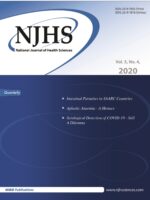Onco-Fertility Tumor Board is Vitally Important for Addressing Fertility
Issues in Cancer Patients
Ahmed Nadeem Abbasi, Fatima Shaukat, Sehrish Abrar, Bilal Qureshi, Nasir Ali, Asim Hafiz
and Hina Hafiz
Some cancers and some cancer treatments can lead to temporary or permanent infertility. Infertility is a special issue which need to be considered and addressed in cancer patients who may face this issue due to their malignancy itself or due to the treatment offered to them. Our team had reviewed contemporary literature and came to the opinion that it is vitally important to establish a specialized board of experts who can have regular board meetings in which all selected cases of cancer patients are discussed who can potentially suffer from some form of temporary or permanent infertility. The relationship between infertility and cancer is being documented in various studies and systemic reviews published lately [1, 2]. Counselling of patients and their next of kin is also an important aspect of this proposed multi-disciplinary team (MDT) Board .Before making any consideration regarding the relevance of the issue of infertility in selected cases of cancer the multidisciplinary team has to develop robust processes in order to make sure that we will not be missing this important problem which our cancer patients may face at the time of diagnosis, treatment or later on as a late sequela of oncological treatment. Practice committee on onco-fertility consortium made clear recommendations highlighting the importance of expert team involvement. The proposals are being published in January 2021 issue of Journal of assisted reproduction [3]. This document provides a valuable insight regarding the establishment healthcare quality processes and their practical implications.
Received: May 31, 2021
Revised: June 24, 2021
Accepted: June 25, 2021
![]()
doi.org/10.21089/njhs.54.0146
Pharmacovigilance – A Medication Safety Perspective
Syed Saad Hussain
The aim of pharmacovigilance (PV) is to evaluate the risk of adverse events of medication being administered to patients keeping in mind that no medication is completely safe [1]. Goal of therapeutics is to improve patient quality of life with minimizing risk and harmful effects associated with it. Medication safety is the process which optimizes the use of medicines and prevents from harm. Medicines are generally safe but as chemical in nature and xenobiotics to living organism are associated with unknown and known risk. Previously, drug safety issues were not discussed galanty due to false adversity consideration [2], but with time and awareness this has changed with highlighting the importance and necessity of pharmacovigilance. WHO classifies pharmacovigilance as the science and process that is associated with detection, assessment, understanding and prevention of adverse effects or any other drug related problem [3]. Moreover, we should consider that the medications to be administered to patient must be assessed by the science of pharmacovigilance. It is the activity that majorly involve monitoring the effect of any medication during its life cycle starting from manufacturing to the patient’s use [4].
Received: February 16, 2021
Revised: June 22, 2021
Accepted: June 23, 2021
doi.org/10.21089/njhs.54.0148
Prevalence of Intestinal Parasites and Associated Risk Factors in Chepang Community of Saktikhor Area, Chitwan, Nepal
Srijana Adhikari, Janak Raj Subedi and Shanti Chaudhary
Abstract: Objective: Pathogenic species of protozoa and helminth cause intestinal parasitosis, which continues to be a significant community well-being issue in many regions of the world, especially in pastoral regions of developing countries like Nepal. The study focused on determining the prevalence of intestinal parasitic infections and the associated risk factors among the people of the Chepang community of the Saktikhor area in the Chitwan district.
Materials and Methods: A transversal study was conducted between May 2017 and October 2017, with a total of 125 participants. The fecal samples were examined using a wet media (saline media, iodine preparation), concentration and sucrose flotation method. The association between risk factors and parasitic prevalence was evaluated using the Pearson’s chi-square test.
Received: February 05, 2021
Revised: May 19, 2021
Accepted: May 24, 2021
doi.org/10.21089/njhs.54.0150
Clinicohematological Characteristics and Survival Analysis of Aplastic Anemia in Pakistan; A Single Centre Experience
Nida Anwar, Aisha Arshad, Naveena Fatima, Sumaira Shaheen and Tahir Sultan Shamsi
Abstract: Objective: Aplastic anemia (AA) is characterized by pancytopenia and hypocellular bone marrow. Several factors like infections, toxins, chemotherapeutics and radiations are known causes for the suppression of hematopoietic cells which results in bone marrow failure but the exact etiology is unknown. The current study was conducted to assess the baseline demographics, laboratory and clinical characteristics of patients presenting with aplastic anemia and evaluate their cytogenetic profile.
Materials and Methods: A retrospective cohort study conducted at National Institute of Blood Diseases and Bone Marrow Transplantation after approval by Institutional Ethics Committee. In this study, AA patients were enrolled from January 2010 to December 2018. Data collection included demographic, laboratory and clinical characteristics including age, gender, symptoms, treatment, and blood counts. Cytogenetic analysis was performed on bone marrow samples. Data analysis was done by using SPSS version 23.
Received: November 30, 2020
Revised: April 30, 2021
Accepted: May 07, 2021
doi.org/10.21089/njhs.54.0157
Diagnostic Performance of Three Serological Assays for Anti-SARS-CoV-2 Antibody Detection
Shabnam Dildar, Asma Danish, Mehjabeen Imam, Arshi Naz and Tahir Sultan Shamsi
Abstract: Objective: To evaluate the diagnostic performance of Electrochemiluminescence (ECLIA) enzyme linked immunosorbent (ELISA) and lateral flow Immunofluorescence (LFIA) for anti-SARS-COV-2 antibody detection.
Materials and Methods: Sensitivity was calculated with convalescent plasma (CP) donor’s samples. Specificity was checked by using pre-pandemic October 2019 samples. All samples were tested for anti-SARS-COV-2 antibody by using Electrochemiluminescence (ECLIA), Enzyme Linked Immunosorbent Assay (ELISA) and Lateral flow Immunofluorescence (LFIA) assay.
Received: September 09, 2020
Revised: April 03, 2021
Accepted: April 07, 2021
doi.org/10.21089/njhs.54.0162
Comparison of Open Gastrostomy and Percutaneous Endoscopic Gastrostomy in Head and Neck Cancer Patients, Tertiary Care Hospital Experience
Talha Ahmed Qureshi, Shabir Akhtar, Sohail Awan, Amir Shariff and Mohammad Adeel
Abstract: Objective: The current study was conducted to review and compare PEG and Gastrostomy in terms of early complications in head and neck cancer patients.
Materials and Methods: This was prospective comparative study recruited total 60 patients as per the inclusion criteria, 30 in each group. Patients were assigned to the groups based on the surgeon’s choice. Ethical clearance was taken from ethical review board. Informed consent was taken from patients before enrolling them into the study. Non-probability consecutive sampling technique was used to enroll study participants. Data was collected on pre-designed performa and analyzed using SPSS version 16.
Received: February 09, 2021
Revised: June 10, 2021
Accepted: June 17, 2021
doi.org/10.21089/njhs.54.0166
Pediatric Chronic Myeloid Leukemia with Megakaryocytic Blast Crisis as Initial Presentation: Case Report and Review of Literature
Tuba Iqbal, Amber Younus, Uzma Zaidi, Jawad Hassan and Tahir Sultan Shamsi
Abstract: Background: Pediatric Chronic Myeloid Leukemia (CML) is a rare entity accounting for 2-3% of pediatric malignancies. CML rarely presents as Blast Crisis (BC) at the time of diagnosis, and megakaryocytic blast crisis is even rarer.
Case Presentation: We herein, report a case of a young female, 10-year-old who presented with anemia, leukocytosis and massive splenomegaly. Clinical features, peripheral film and bone marrow findings were consistent with CML in megakaryocytic blast crisis. Bone marrow cytogenetic analysis revealed karyotype of 46, XX, t(9:22)(q34;q11.2) in 20 metaphases and BCR-ABL P210 by PCR was detected with transcript level of 83%, which further confirmed our diagnosis.
Received: July 26, 2020
Revised: November 13, 2020
Accepted: November 23, 2020
doi.org/10.21089/njhs.54.0171
Variceal Bleeding in Patients with Initation of Sofosbuvir and Ribavirin – Case Reports
Sadiq Memon, Madiha Zaki and Shahzad Ali Jiskani
Abstract: Sofosbuvir is an oral nucleoside analogue and potent inhibitor of the Hepatitis C virus (HCV) RNA polymerase that is used in combination with other antiviral agents to treat chronic Hepatitis C Nevertheless, and for unknown reasons, successful antiviral therapy of Hepatitis C with Sofosbuvir and other direct acting agents in patients with cirrhosis is occasionally complicated by hepatic decompensation. Here we describe 2 case report of upper gi bleed at initial days of treatment with Sofosbuvir and Ribavirin.
Received: August 30, 2020
Revised: November 05, 2020
Accepted: November 27, 2020
doi.org/10.21089/njhs.54.0175
Median Arcuate Ligament Syndrome: An Exceptional Cause of Abdominal Pain
Satilmis Bilgin, Gulali Aktas, Ozge Kurtkulagi, Tuba Taslamacioglu Duman, Burcin Meryem
Atak, Gizem Kahveci, Mehmet Zahid Kocak and Haluk Savli
Abstract: Median Arcuate Ligament Syndrome (MALS) is caused by the compression of celiac artery by median arcuate ligament and may cause serious symptoms; such as abdominal pain and weight loss. Here we present a 56 year old man with MALS, whom suffered of postprandial abdominal pain, weight loss, nausea and vomiting. Laparoscopic surgery revealed his symptoms after MALS diagnosis was established. In conclusion, MALS should be considered in the differential diagnosis of patients with complaints of postprandial abdominal pain, nausea and weight loss. Laparoscopic surgery could be as successful as other treatment options in these patients.
Received: October 22, 2020
Revised: November 27, 2020
Accepted: December 11, 2020
doi.org/10.21089/njhs.54.0177
A Case Report: An Overweight Patient with High Dose Insulin Usage
Burcin Meryem Atak and Mustafa Ramiz Tel
Abstract: Insulin is vital for patients with type 1 diabetes and useful for certain patients with type 2 diabetes [1]. In this article we aim to explain a case wrongly using high dosage insulin. A 68-year-old female patient with known 10 years of type 2 diabetes mellitus and hypertension came to our outpatient clinic because her blood glucose levels were high at home. She was using perindopril 10 mg, metformin and insulin. Since the patient did not want to make multiple injections her previous doctor has changed her therapy from glargine u300 1×50 units and insulin aspart 3×30 units to a mixed insulin; insulin degludec + insulin aspart, as 2x 40 units per day. However, the patient did not understand the change of treatment and made the combination of insulin glargine u300 1×50 units and insulin degludec + insulin aspart two times a day as 30 units. She was using this therapy more than two months.
Received: October 20, 2020
Revised: December 15, 2020
Accepted: December 15, 2020
doi.org/10.21089/njhs.54.0180

2020 VOL 5 , Issue 4
